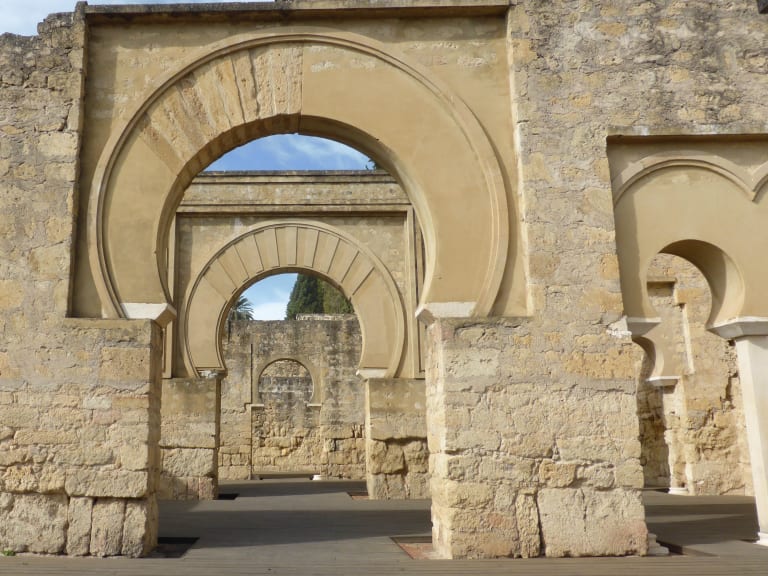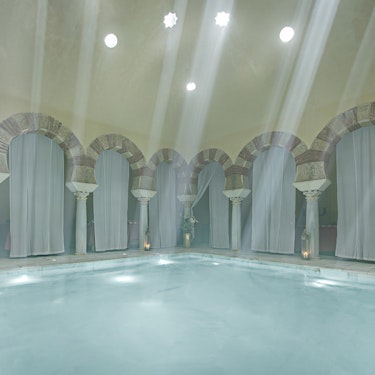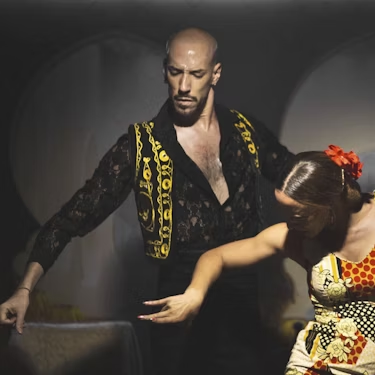More about: Tours and Day Trips to Medina Azahara from Cordoba
Córdoba is one of Spain's most exciting cities thanks to its impressive cultural heritage and fascinating history. The period of greatest splendour of Al-Andalus was the Umayyad Caliphate, and as a symbol of this greatness, a new city called Medina Azahara was built on the outskirts of Córdoba, the most beautiful city in the Islamic West, which only survived for 70 years.
Today, you can visit its remains just 8 kilometres from Córdoba and reconstruct in your mind what was once the glory of Medina Azahara. For me, it is undoubtedly one of the essential excursions to do in Córdoba during your holiday. Let me tell you about the best tours and excursions!
The best option: Guided tour of Medina Azahara with optional transfer from Córdoba

On this 3-hour tour of Medina Azahara from Córdoba, you'll travel to the heart of the Caliphate of Córdoba, the golden age of Al-Andalus, accompanied by a guide who will tell you the fascinating history of the brilliant city of Abd-ar-Rahman III and show you the remains of this interesting archaeological site on foot.
What does this excursion include?
This tour to Medina Azahara from Córdoba consists of two parts: a visit to the archaeological site of Medina Azahara and a visit to its Interpretation Centre.
The tour begins at around 10:15 a.m. at the Cruz Roja roundabout, where you will take the bus (if you choose the option that includes transfer from Córdoba) that will take you to the Medina Azahara complex. Your guide will be waiting for you there, and you will be able to identify them by their orange umbrella. Once you have given them your booking name, you will join the group and board another bus to the ruins of the palatine city, located 2 kilometres from the Interpretation Centre.
In Medina Azahara, you will spend about 2 hours with the guide walking among the remains of palaces, ceremonial halls, mosques and workshops, learning all the stories and surprising anecdotes about this archaeological site, which was declared a World Heritage Site by UNESCO in 2018.
At the end of the tour, you will return to the site's Interpretation Centre to begin the second part of this excursion to Medina Azahara, which includes a visit to the museum, also accompanied by a guide who will explain all the collections on display and give you a more complete overview of the site's activity. You'll learn so much!
Finally, you'll arrive in Córdoba around 1:30 PM, a great time to have lunch and continue your holiday in this Andalusian city.
Details of interest
- Price: from £23
- Duration: approximately 3 hours in total
- Transport: shuttle bus (optional)
- Recommended... if you are looking for an affordable, comprehensive option with a guide and museum included
The premium option: Private tour of Medina Azahara just for you and your group

If you prefer a more personalised experience at your own pace, this private tour of Medina Azahara from Cordoba is an excellent option. During the 1.5-hour tour, you will learn about the legacy of Caliph Abd-ar-Rahman III in the company of an expert guide just for you or your group, allowing you to delve deeper into the history and architectural details of this important Andalusian site.
What does this excursion include?
Unlike the group tour, this option focuses on the palatine city itself and does not include transport from Cordoba or a guided tour of the museum or interpretation centre, although it does include access to these areas so that you can explore them on your own once the private tour of the site has ended.
During the tour of the ruins, you will see highlights such as the Caliphate palace, the residences of the servants and guards, and discover why Medina Azahara was a symbol of Umayyad power in the 10th century. Declared a UNESCO World Heritage Site in 2018, this palatial city continues to fascinate with its design, political symbolism and history.
Details of interest
- Price: from £121
- Duration: approximately 1.5 hours
- Transport: transfer to Medina Azahara is not included
- Recommended if... you are looking for a more exclusive experience without crowds and are travelling with a group with whom you can share the cost of the tour
Can I organise a visit to Medina Azahara on my own?

If you decide to do this excursion on your own, in order to better understand the importance of Medina Azahara in the history of Spain, I recommend that you first visit the Interpretation Centre located near the archaeological ruins and then the palatine city, to get a better idea of what it was and what it meant in Al-Andalus before seeing the remains in person.
To organise your trip to Medina Azahara on your own, I recommend downloading two maps with the itineraries to the museum and the archaeological site, which you can find on the official website. They will definitely help you plan your visit!
How to get to Medina Azahara on your own?

By bus
A tourist bus leaves from Avenida del Alcázar to the Medina Azahara Interpretation Centre. To get a ticket for this bus, you must reserve a seat at the Cordoba tourist office at least one day in advance.
By car
From the centre of Córdoba, you can reach the Medina Azahara Interpretation Centre by taking the A-431 road to Palma del Río until you see the sign for Madinat al-Zahra.
Once you arrive at the site, you will need to park your car in the museum car park and take the shuttle bus to the archaeological site, which is located two kilometres from the centre. It leaves every 20 minutes and bus tickets can be purchased at the museum.
How to get to the archaeological site?
As mentioned above, the archaeological site of Medina Azahara is located 2 kilometres from the Interpretation Centre, so there is a shuttle bus that connects the two points, which you can take after purchasing your ticket and registering at the museum.
This bus runs continuously during the centre's opening hours and passes every 15 to 20 minutes. The ticket costs £2.50 (general fare) and £1.50 (reduced fare for senior citizens and children aged 5 to 12) and includes return travel. Children under 5 travel free.
The last shuttle bus to take visitors to the ruins of Medina Azahara leaves from the car park of the Interpretation Centre 60 minutes before closing time.
Please remember that this is the only way to access the site, as private vehicles are not allowed in the old palatine city.
Opening hours and admission prices for Medina Azahara

Opening
Medina Azahara is open Tuesday to Saturday from 9 AM to 6 PM. On Sundays, public holidays and the eve of public holidays, it is open from 9 AM to 3 PM. Closed on Mondays. Also closed on 1 January, 6 January, 1 May, 24 December, 25 December and 31 December.
Depending on the month and season, opening hours may vary and night visits are only available at the Medina Azahara archaeological site from 7 PM to 12 AM. For more information, please check the official website.
Admission
- Free for accredited citizens of the European Union.
- Admission for citizens of other countries is 1.50 euros.
Why take a tour or excursion to Medina Azahara?

The Alhambra in Granada is the Andalusian palatine city that captures everyone's attention and is known throughout the world for its impressive beauty and excellent state of preservation. It receives millions of visitors every year, with people queuing for hours at the ticket offices to gain access and tickets selling out months in advance.
However, not many travellers are aware of the existence of Medina Azahara, the predecessor of the Alhambra in terms of Andalusian palatine cities.
This is because the two palace complexes suffered very different fates. While the Alhambra was preserved after the end of the Reconquista, Medina Azahara's life was very short-lived, as it was destroyed during the civil war that ended the Umayyad Caliphate and gave way to the Taifa kingdoms. Abandonment, the passage of time and looting did the rest.
However, thanks to the restoration work carried out at Medina Azahara, it is possible to get an idea of the extraordinary beauty that this Caliphate city had in its origins. For those of us who are passionate about history and art, it is wonderful to be able to walk around the site imagining what Medina Azahara was like during its heyday and the great political, cultural and commercial importance it had in the Middle Ages.
What is Medina Azahara like?

I remember walking through the ruins of Medina Azahara as if I had travelled back in time to the heyday of Al-Andalus and the Umayyad dynasty in Spain. What an exciting experience!
I found it fascinating to have the opportunity to stroll through the oldest Andalusian palace city in the country. The pearl of one of the great empires in the Mediterranean, comparable to the Byzantine Empire in its time, architects from Baghdad and Constantinople were brought in to build it.
A visit to Medina Azahara is an adventure in itself. As it is not possible to access the site by car, you have to park in the car park at the Interpretation Centre, register and buy your ticket here before taking the shuttle bus that will take you to the monumental complex.
Although it is very tempting, it is not possible to reach Medina Azahara by walking through the countryside and enjoying the landscape because the road becomes narrow and dangerous in some places.
Once registered, I got on the bus that connects the museum with the site (it runs every 15 to 20 minutes) and soon arrived at Medina Azahara.
What to see in Medina Azahara?
The first thing that caught my attention was the privileged location of Medina Azahara.
Taking advantage of the natural slope of the land, the city was designed as a system of terraces on three levels, with the Royal Alcázar (the caliph's residence, from where he could contemplate the Guadalquivir valley) built on the upper level, the middle level dedicated to administrative buildings and the homes of court officials, and the lower level occupied by the medina itself.
Although the city was destroyed by war and later by looting, I was surprised to find that there are still traces of the opulent decoration that this palatine city once had.
The decoration of the palatine city
Caliph Abd-ar-Rahman III spared no expense, as Medina Azahara represented the power of his newly proclaimed caliphate and, therefore, everything was designed to show the world the splendour of the Umayyad dynasty.
White marble was brought from Portugal for the columns and capitals, alabaster was used for the floors of the most important rooms, and local purple limestone provided an exquisite contrast between the red decorations and the white walls.
Add to this the profuse decoration with plant motifs, the epigraphic inscriptions, the gardens, the fountains and the ponds, and it is easy to understand why Medina Azahara was once considered one of the most splendid cities ever built by man.
What are its most outstanding features?
Here you can see the Caliph's Royal House and the magnificent Rico Hall, where political receptions were held in the city and which was characterised by its rich decoration. Also worth seeing are the Aljama Mosque and the House of Yafar, the residence of the prime minister of Caliph Al-Hakam II, who built the maqsura of the Mosque of Cordoba.
Other places of interest include the great portico, the eastern entrance to the Alcázar area, and the House of the Alberca, which is believed to have been the home of Caliph Al-Hakam II.
What is the Interpretation Centre like?
The aim of this museum is to promote the study and dissemination of the archaeological site of Medina Azahara and to serve as a bridge between the Western and Eastern worlds.
The tour is an introduction to Medina Azahara lasting about 60 minutes, which will allow you to discover its history through four permanent exhibitions on the following topics:
- The foundation of the city and its context.
- The construction of Madinat al-Zahra.
- The city and its inhabitants.
- The destruction and recovery of Madinat al-Zahra.
All the historical objects found in the archaeological excavations are preserved here, and a 15-minute audiovisual documentary called "Madinat al-Zahra: the shining city" is shown, which is well worth watching to learn more about what Medina Azahara was like and what life was like there, as it was home to more than 20,000 people at the time.
How was Medina Azahara founded?
How was Medina Azahara founded?

Legend has it that Abderramán III, the first Caliph of Córdoba, ordered the construction of the palatial city of Medina Azahara at the foot of the Sierra Morena mountains in the 9th century to please Azahara, his favourite concubine.
However, the real origin of this palace complex is not to be found in the romanticism of the ruler, but in a purely political reason.
On the one hand, the caliph wanted to consolidate his image of power after establishing the independent Caliphate of Córdoba and sought to promote his power, wealth and good taste to rival kingdoms. On the other hand, Abd-ar-Rahman III also wanted to distance himself from his subjects in a city as populated as Cordoba was at the time and live in an idyllic place separated from the rest of society, in keeping with the medieval mentality of the time.
Why did Medina Azahara disappear?

The great work of Abd al-Rahman III was Medina Azahara, symbol of the political power of the self-proclaimed caliph of Al-Andalus. With the death of his son Alhakam II, the caliphate of his grandson Hisham II began. Hisham II indulged in worldly pleasures and was a puppet in the hands of his vizier, the famous Almanzor, who ended up becoming the leader of Al-Andalus.
Almanzor abandoned Medina Azahara and founded Medina Alzahira, his own palatine city, located west of Cordoba, which has not been located to date.
What no one could have suspected was that the days of the Umayyad Caliphate were numbered. It disappeared for good in 1031, after a fierce civil war that overthrew Hisham III and led to the division of the territory into different kingdoms known as the Taifa kingdoms.
From then on, Medina Azahara was burned and looted. It fell into oblivion for centuries, until 1911, when the first archaeological excavations brought to light the remains of the ancient Umayyad palatine city, which was declared a World Heritage Site in 2018.
Tips for taking a tour or excursion to Medina Azahara

When to visit Medina Azahara?
Any time of year is good for visiting Medina Azahara, although temperatures in summer tend to be quite high. That's why during this season I recommend visiting first thing in the morning or late in the afternoon.
Can you buy food or drink at the archaeological site?
It is not possible to buy water or food inside, so I recommend bringing a bottle and some nuts to snack on in your backpack in case you get hungry.
However, the Interpretation Centre has a café-restaurant where you can recharge your batteries after the tour.
What should I wear to visit Medina Azahara?
There is a lot to see on a visit to Medina Azahara, so you will be walking for quite a while. Remember to wear comfortable clothing and footwear, and protect yourself from the cold in winter and the sun in summer.
How to complete your tour or excursion to Medina Azahara?

If you are planning a getaway to Córdoba, I recommend taking an excursion to Medina Azahara and completing it with a visit to the cathedral-mosque to understand the importance of the Umayyad capital in the 10th century.
In my article Tickets for the Mosque of Cordoba, I give you all the details on how to get tickets to this temple and the different tours available.
If you are travelling to Andalusia in the footsteps of Al-Andalus, another magnificent palatine city to discover is the Alhambra in Granada.
If you want to include it in your trip, there are several options for exploring this wonderful medieval Nasrid fortress. I explain them in detail in my article Tickets and guided tours of the Alhambra in Granada.















